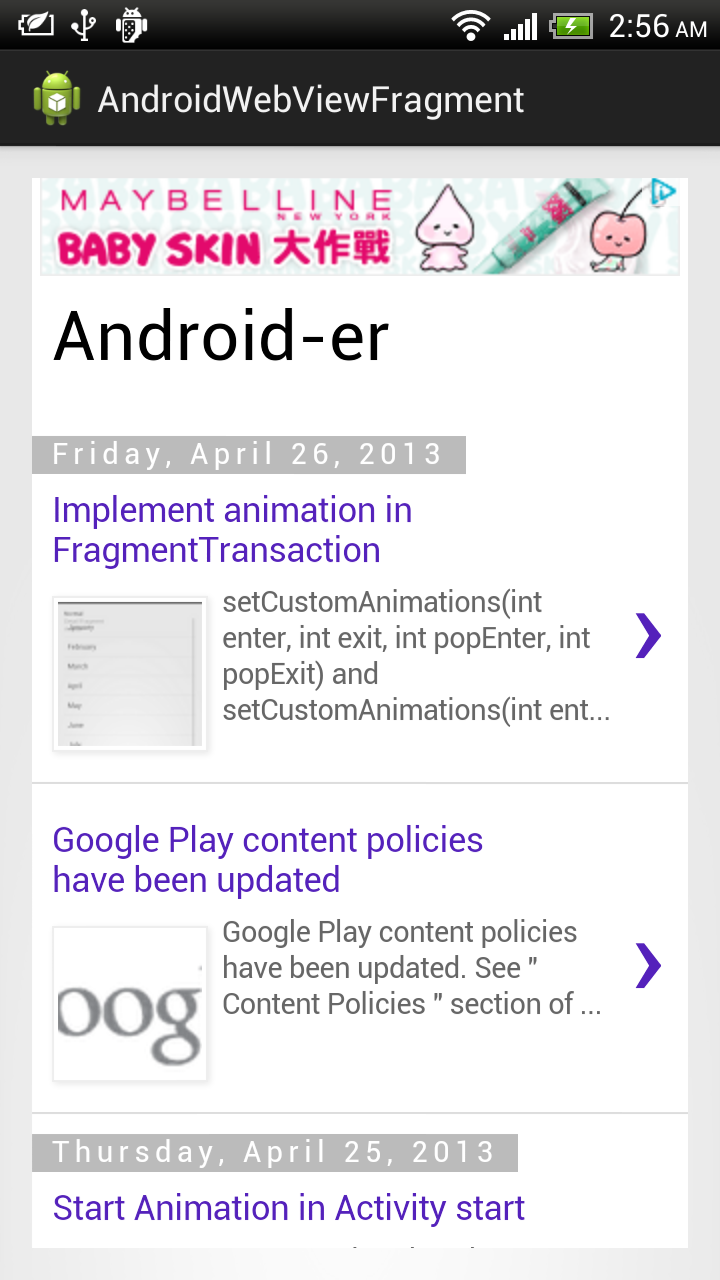Embed webview in fragment
this comes frome: http://android-er.blogspot.com/2013/04/embed-webview-in-fragment.html?utm_source=tuicool
This exercise embed WebView in Fragment.

package com.example.androidwebviewfragment;
import android.os.Bundle;
import android.app.Activity;
import android.app.Fragment;
import android.view.LayoutInflater;
import android.view.View;
import android.view.ViewGroup;
import android.webkit.WebView;
import android.webkit.WebViewClient;
public class MainActivity extends Activity {
static public class MyWebViewFragment extends Fragment {
WebView myWebView;
final static String myBlogAddr = "http://android-er.blogspot.com";
String myUrl;
@Override
public View onCreateView(LayoutInflater inflater, ViewGroup container,
Bundle savedInstanceState) {
View view = inflater.inflate(R.layout.layout_webfragment, container, false);
myWebView = (WebView)view.findViewById(R.id.mywebview);
myWebView.getSettings().setJavaScriptEnabled(true);
myWebView.setWebViewClient(new MyWebViewClient());
if(myUrl == null){
myUrl = myBlogAddr;
}
myWebView.loadUrl(myUrl);
return view;
}
private class MyWebViewClient extends WebViewClient {
@Override
public boolean shouldOverrideUrlLoading(WebView view, String url) {
myUrl = url;
view.loadUrl(url);
return true;
}
}
@Override
public void onActivityCreated(Bundle savedInstanceState) {
super.onActivityCreated(savedInstanceState);
setRetainInstance(true);
}
}
@Override
protected void onCreate(Bundle savedInstanceState) {
super.onCreate(savedInstanceState);
setContentView(R.layout.activity_main);
}
@Override
public void onBackPressed() {
MyWebViewFragment fragment =
(MyWebViewFragment)getFragmentManager().findFragmentById(R.id.myweb_fragment);
WebView webView = fragment.myWebView;
if(webView.canGoBack()){
webView.goBack();
}else{
super.onBackPressed();
}
}
}
Layout, activity_main.xml.
<RelativeLayout xmlns:android="http://schemas.android.com/apk/res/android"
xmlns:tools="http://schemas.android.com/tools"
android:layout_width="match_parent"
android:layout_height="match_parent"
android:paddingBottom="@dimen/activity_vertical_margin"
android:paddingLeft="@dimen/activity_horizontal_margin"
android:paddingRight="@dimen/activity_horizontal_margin"
android:paddingTop="@dimen/activity_vertical_margin"
tools:context=".MainActivity" >
<fragment
android:name="com.example.androidwebviewfragment.MainActivity$MyWebViewFragment"
android:id="@+id/myweb_fragment"
android:layout_height="match_parent"
android:layout_width="match_parent" />
</RelativeLayout>
Layout of our fragment, layout_webfragment.xml.
<LinearLayout xmlns:android="http://schemas.android.com/apk/res/android"
xmlns:tools="http://schemas.android.com/tools"
android:layout_width="match_parent"
android:layout_height="match_parent"
android:orientation="vertical" >
<WebView
android:id="@+id/mywebview"
android:layout_height="match_parent"
android:layout_width="match_parent" />
</LinearLayout>
Permission of “android.permission.INTERNET” is need.
- I can’t implement using WebViewFragment, so this exercise extends Fragment, not WebViewFragment.
- In this implement, the WebView can load the last loaded address after orientation changed, but cannot keep the navigation history.